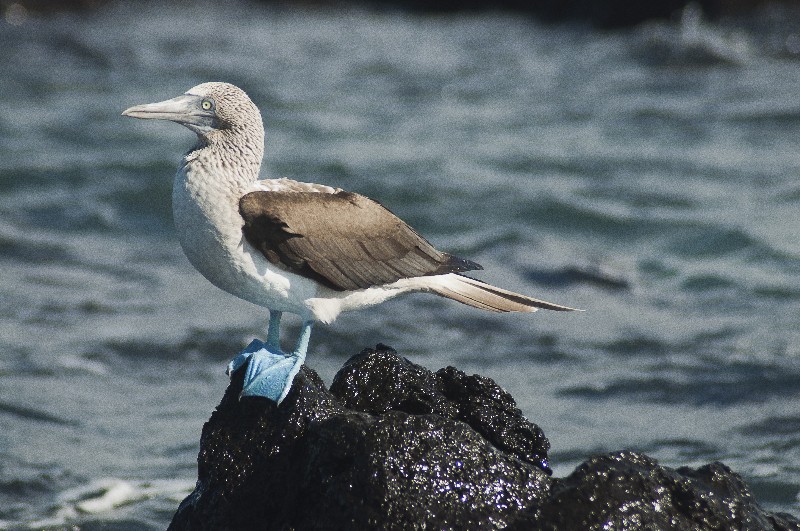"I Love Boobies"

To the uninitiated, the title, “I love boobies” may come off as offensive, although to the “ornithologically” inclined this means something completely different. No we are not talking about the tatas, we are talking about the Sulidae family of birds known as “boobies”. The Booby family is split into a tropical group and a temperate group (known as Gannets) and are large, sea-going birds that occupy a variety of ocean habitat. Boobies are large, typically larger than what most people think of the average Gull species (remember, we don't call them “seagulls” anymore, we learned that last time). Boobies have long pointed wings (up to 4 feet), long pointed bills, and webbed feet, and they come in a variety of colors but mostly brown, white, and black coloration is typical. They have a strange binocular-like vision with both eyes facing forward, which makes them awfully silly looking. It is thought that the spanish conquerors called them “Bobos”, which in spanish means something akin to stupid. They are often unafraid of humans on their breeding grounds, and easy to walk up to and kill. Furthermore, the courtship display of the booby is typically an awkward dance facing each other which is just plain dumb looking. This mixed with a silly look earned them the name, as the tale goes.
If you have been to the Pearl Islands or near Tabogas Island, you are likely to have seen Boobies flying or perching on the cliffs where they nest. An adult Booby is roughly 2 years old by the time they start actively breeding. The young are altricial, which means they are needy and require close and careful adult care. Young Boobies will depend on their parents for 9 months. Boobies have been recorded as old as 27 years. The nest of a booby is variable by species. Some species prefer a loose knit collection of twigs, others just the bare rock of a cliff and even others still, create a cupped nest out of their own guano (thats bird poop, if you didn't know).
Boobies are “plunge divers” which means they spy prey, typically from a good height, in large flocks, then dive straight into the ocean face first, and submerge to catch fish by the bill. Boobies can dive from heights upwards of 300 feet and have been recorded submerging as much as 75 feet! They are often looking to catch squid, anchovies, flying fish, pilchards, and other small schooling fish. Imagine the body mechanics required to dive, full speed at terminal velocity, and breaking through the water and furthermore “flying” underwater to catch your prey! These birds are some of only a few who have adapted to this hunting style in the world.
In Panama we have several Booby species which we can see and careful observation can help you differentiate between them. In fact, of late, there has been an influx of a Booby not regularly seen in our waters, called the Peruvian Booby. Close and careful study might initiate a “Rare Bird Alert” for our birding community in Panama! Lets start with the common species that can regularly be seen in offshore:
The Blue-footed Booby. The first impression of the bird is large, brown and pointy. The bird has a wingspan of approximately 62 inches. An adult will have a dark pointed conical bill, brown and whitish head with a whitish patch on the nape (back of the neck). The upper breast is largely white, the wings brown. Rarely are you able to see the blue-feet in flight, only extreme close proximity will allow this.
The Brown Booby. A tiny bit smaller than the Blue-footed, sporting a wing span of 57 inches or 145 centimeters, the Brown Booby is considered the most common of all boobies in Panama. The adult sports a yellow conical bill and a completely dark brown head. The adult in flight looks like its wearing a brown bib which turns to a completely white belly below the upper breast. The back and wings are dark brown above with some small whitish coloring below. The bird has a very “neat” look compared to the “dirty” look of the Blue-footed Booby. If you get close enough to a flying bird or are able to see them at a nesting colony, adults are sporting yellow feet.
The Red-footed Booby is possible to see in Panama, but there are few verifiable observations of this bird. Most sightings have occurred on the Caribbean coast and it is considered a vagrant. There have been only a few verified sightings of this species on the Pacific. The adult dark morph individual looks like a juvenile Brown Booby, dark chocolate all over, with darker brown wing feathers and tail feathers. You typically cannot see the red foot of the bird unless its extremely close or sitting.
A species seen especially during an El Niño cycle, the Peruvian Booby, is currently being recorded in Panamanian waters now, so be on the look out! The Peruvian adult looks awfully alike to a Blue-footed Booby with the exception of an all white head. Otherwise the similarity of a dirty brown/white body and tail are similar. If you have good eyes or binoculars you will also notice a striking difference in the upper wing. The Peruvian Booby has a dirtier look to the upper wing with much whitish coloring at the base of the flight feathers whereas the adult Blue-footed Booby has a very distinctly solid brown coloring (two-toned) on the upper wing.
For references and illustrations of these species see Angher & Dean “The Birds of Panama” pages 20 - 23 or Ridgely´s “A Guide to the Birds of Panama” on pages 60 - 62. If you are interested in recent observations of Peruvian Booby´s in Panama, go to xenornis.com for up to date reports with directions.
As per usual, questions and comments are welcome: ezekieljakub@conservacionpanama.org
